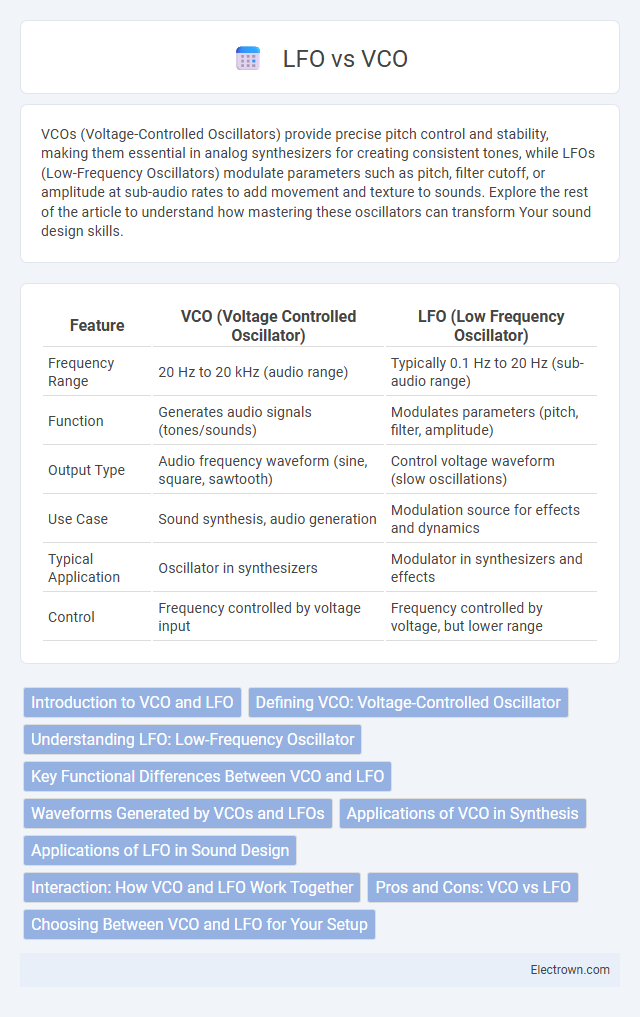VCOs (Voltage-Controlled Oscillators) provide precise pitch control and stability, making them essential in analog synthesizers for creating consistent tones, while LFOs (Low-Frequency Oscillators) modulate parameters such as pitch, filter cutoff, or amplitude at sub-audio rates to add movement and texture to sounds. Explore the rest of the article to understand how mastering these oscillators can transform Your sound design skills.
Table of Comparison
| Feature | VCO (Voltage Controlled Oscillator) | LFO (Low Frequency Oscillator) |
|---|---|---|
| Frequency Range | 20 Hz to 20 kHz (audio range) | Typically 0.1 Hz to 20 Hz (sub-audio range) |
| Function | Generates audio signals (tones/sounds) | Modulates parameters (pitch, filter, amplitude) |
| Output Type | Audio frequency waveform (sine, square, sawtooth) | Control voltage waveform (slow oscillations) |
| Use Case | Sound synthesis, audio generation | Modulation source for effects and dynamics |
| Typical Application | Oscillator in synthesizers | Modulator in synthesizers and effects |
| Control | Frequency controlled by voltage input | Frequency controlled by voltage, but lower range |
Introduction to VCO and LFO
VCO (Voltage-Controlled Oscillator) is an electronic oscillator whose frequency is controlled by an input voltage, widely used in synthesizers to generate precise tones. LFO (Low-Frequency Oscillator) operates at sub-audio frequencies and modulates parameters such as pitch, amplitude, or filter cutoff, creating effects like vibrato or tremolo. Both VCO and LFO are fundamental components in sound synthesis, with VCO providing the primary audio signal and LFO adding dynamic modulation.
Defining VCO: Voltage-Controlled Oscillator
A Voltage-Controlled Oscillator (VCO) generates audio signals whose frequency is determined by an input voltage, making it a fundamental component in analog synthesizers. Unlike a Low-Frequency Oscillator (LFO) that modulates parameters at sub-audio rates, VCOs produce audible tones essential for melody and harmony. Understanding VCO operation helps you manipulate sound synthesis with precision and dynamic control.
Understanding LFO: Low-Frequency Oscillator
Low-Frequency Oscillators (LFOs) generate cyclical waveforms below 20 Hz, primarily used to modulate parameters such as pitch, amplitude, and filter cutoff in synthesizers, creating effects like vibrato and tremolo. Unlike Voltage-Controlled Oscillators (VCOs), which generate audible tones, LFOs operate at sub-audio frequencies to shape sound characteristics dynamically over time. Understanding LFO wave shapes and rates is crucial for sound design, enabling precise control over modulation depth and rhythm.
Key Functional Differences Between VCO and LFO
A VCO (Voltage-Controlled Oscillator) generates audio-frequency signals that serve as sound sources in synthesizers, producing waveforms such as sine, square, and sawtooth. An LFO (Low-Frequency Oscillator) operates at sub-audio frequencies, primarily used to modulate parameters like pitch, amplitude, or filter cutoff, creating effects such as vibrato or tremolo. Understanding the key functional differences between VCO and LFO helps you shape sound design by distinguishing between primary sound generation and modulation roles.
Waveforms Generated by VCOs and LFOs
VCOs generate a wide variety of audio-frequency waveforms including sawtooth, square, triangle, and sine waves, essential for creating rich, harmonically complex sounds in synthesizers. LFOs primarily produce low-frequency waveforms such as sine, triangle, and square waves that modulate parameters like pitch, filter cutoff, or amplitude, adding movement and expression to your sound. Understanding the distinct waveform characteristics of VCOs and LFOs enables precise control over both the tonal foundation and dynamic modulation in your music production.
Applications of VCO in Synthesis
VCOs (Voltage-Controlled Oscillators) generate precise audio frequencies essential for creating musical tones in analog and modular synthesizers by converting voltage inputs into oscillating waveforms like sine, square, or sawtooth. Your sound design benefits from VCOs' stable tuning and rich harmonic content, which serve as the primary source for melodies and basslines in electronic music production. Compared to LFOs (Low-Frequency Oscillators), which modulate parameters at sub-audio rates, VCOs directly provide audible pitch and harmonic material pivotal for synthesis.
Applications of LFO in Sound Design
LFOs (Low-Frequency Oscillators) are essential in sound design for creating modulation effects such as vibrato, tremolo, and filter sweeps by varying parameters rhythmically over time. They provide dynamic movement to static sounds, enriching textures and enabling evolving sonic landscapes in synthesizers and audio processing. VCOs (Voltage-Controlled Oscillators) generate the primary audio signals, but LFOs modulate these signals or other components, making LFOs crucial for expressive and animated sound design.
Interaction: How VCO and LFO Work Together
VCOs (Voltage-Controlled Oscillators) generate the primary audio frequencies, while LFOs (Low-Frequency Oscillators) modulate parameters like pitch, amplitude, or filter cutoff to create dynamic sound variations. The interaction between your VCO and LFO adds movement and texture by periodically altering the VCO's waveform or frequency at sub-audio rates. This modulation technique enhances sonic complexity, enabling effects like vibrato, tremolo, and rhythmic pulsing essential for evolving synth sounds.
Pros and Cons: VCO vs LFO
VCOs (Voltage-Controlled Oscillators) generate audio-rate frequencies essential for sound synthesis, offering precise pitch control and rich harmonic content but may introduce tuning instability due to temperature fluctuations. LFOs (Low-Frequency Oscillators) operate at sub-audio frequencies for modulation purposes, providing smooth modulation of parameters like amplitude, filter cutoff, or pitch, but they do not produce audible tones. Choosing between VCO and LFO depends on the need for either audio generation with dynamic waveforms or slow parameter modulation to add movement and texture to sounds.
Choosing Between VCO and LFO for Your Setup
Selecting between a Voltage-Controlled Oscillator (VCO) and a Low-Frequency Oscillator (LFO) depends on the role each plays in your audio setup; VCOs generate audible frequencies for sound synthesis while LFOs produce sub-audio signals primarily used for modulation effects. Consider VCO for creating pitched sounds like basslines and leads, or LFO to modulate parameters such as filter cutoff, amplitude, or pitch to add movement and complexity. Focusing on the intended sound design application and modulation needs ensures optimal integration of VCOs and LFOs in your modular or electronic music system.
VCO vs LFO Infographic

 electrown.com
electrown.com